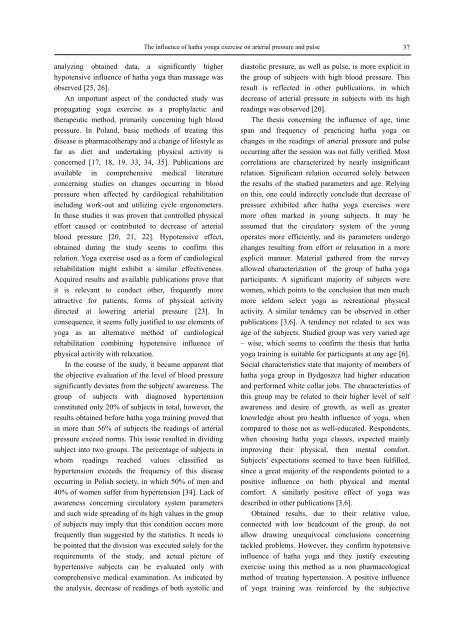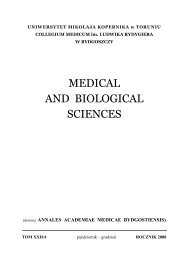Wsparcie spoÅeczne u chorych z miażdżycÄ tÄtnic koÅczyn dolnych
Wsparcie spoÅeczne u chorych z miażdżycÄ tÄtnic koÅczyn dolnych
Wsparcie spoÅeczne u chorych z miażdżycÄ tÄtnic koÅczyn dolnych
You also want an ePaper? Increase the reach of your titles
YUMPU automatically turns print PDFs into web optimized ePapers that Google loves.
The influence of hatha youga exercise on arterial pressure and pulse 37<br />
analyzing obtained data, a significantly higher<br />
hypotensive influence of hatha yoga than massage was<br />
observed [25, 26].<br />
An important aspect of the conducted study was<br />
propagating yoga exercise as a prophylactic and<br />
therapeutic method, primarily concerning high blood<br />
pressure. In Poland, basic methods of treating this<br />
disease is pharmacotherapy and a change of lifestyle as<br />
far as diet and undertaking physical activity is<br />
concerned [17, 18, 19, 33, 34, 35]. Publications are<br />
available in comprehensive medical literature<br />
concerning studies on changes occurring in blood<br />
pressure when affected by cardilogical rehabilitation<br />
including work-out and utilizing cycle ergonometers.<br />
In those studies it was proven that controlled physical<br />
effort caused or contributed to decrease of arterial<br />
blood pressure [20, 21, 22]. Hypotensive effect,<br />
obtained during the study seems to confirm this<br />
relation. Yoga exercise used as a form of cardiological<br />
rehabilitation might exhibit a similar effectiveness.<br />
Acquired results and available publications prove that<br />
it is relevant to conduct other, frequently more<br />
attractive for patients, forms of physical activity<br />
directed at lowering arterial pressure [23]. In<br />
consequence, it seems fully justified to use elements of<br />
yoga as an alternative method of cardiological<br />
rehabilitation combining hypotensive influence of<br />
physical activity with relaxation.<br />
In the course of the study, it became apparent that<br />
the objective evaluation of the level of blood pressure<br />
significantly deviates from the subjects' awareness. The<br />
group of subjects with diagnosed hypertension<br />
constituted only 20% of subjects in total, however, the<br />
results obtained before hatha yoga training proved that<br />
in more than 56% of subjects the readings of arterial<br />
pressure exceed norms. This issue resulted in dividing<br />
subject into two groups. The percentage of subjects in<br />
whom readings reached values classified as<br />
hypertension exceeds the frequency of this disease<br />
occurring in Polish society, in which 50% of men and<br />
40% of women suffer from hypertension [34]. Lack of<br />
awareness concerning circulatory system parameters<br />
and such wide spreading of its high values in the group<br />
of subjects may imply that this condition occurs more<br />
frequently than suggested by the statistics. It needs to<br />
be pointed that the division was executed solely for the<br />
requirements of the study, and actual picture of<br />
hypertensive subjects can be evaluated only with<br />
comprehensive medical examination. As indicated by<br />
the analysis, decrease of readings of both systolic and<br />
diastolic pressure, as well as pulse, is more explicit in<br />
the group of subjects with high blood pressure. This<br />
result is reflected in other publications, in which<br />
decrease of arterial pressure in subjects with its high<br />
readings was observed [20].<br />
The thesis concerning the influence of age, time<br />
span and frequency of practicing hatha yoga on<br />
changes in the readings of arterial pressure and pulse<br />
occurring after the session was not fully verified. Most<br />
correlations are characterized by nearly insignificant<br />
relation. Significant relation occurred solely between<br />
the results of the studied parameters and age. Relying<br />
on this, one could indirectly conclude that decrease of<br />
pressure exhibited after hatha yoga exercises were<br />
more often marked in young subjects. It may be<br />
assumed that the circulatory system of the young<br />
operates more efficiently, and its parameters undergo<br />
changes resulting from effort or relaxation in a more<br />
explicit manner. Material gathered from the survey<br />
allowed characterization of the group of hatha yoga<br />
participants. A significant majority of subjects were<br />
women, which points to the conclusion that men much<br />
more seldom select yoga as recreational physical<br />
activity. A similar tendency can be observed in other<br />
publications [3,6]. A tendency not related to sex was<br />
age of the subjects. Studied group was very varied age<br />
– wise, which seems to confirm the thesis that hatha<br />
yoga training is suitable for participants at any age [6].<br />
Social characteristics state that majority of members of<br />
hatha yoga group in Bydgoszcz had higher education<br />
and performed white collar jobs. The characteristics of<br />
this group may be related to their higher level of self<br />
awareness and desire of growth, as well as greater<br />
knowledge about pro health influence of yoga, when<br />
compared to those not as well-educated. Respondents,<br />
when choosing hatha yoga classes, expected mainly<br />
improving their physical, then mental comfort.<br />
Subjects' expectations seemed to have been fulfilled,<br />
since a great majority of the respondents pointed to a<br />
positive influence on both physical and mental<br />
comfort. A similarly positive effect of yoga was<br />
described in other publications [3,6].<br />
Obtained results, due to their relative value,<br />
connected with low headcount of the group, do not<br />
allow drawing unequivocal conclusions concerning<br />
tackled problems. However, they confirm hypotensive<br />
influence of hatha yoga and they justify executing<br />
exercise using this method as a non pharmacological<br />
method of treating hypertension. A positive influence<br />
of yoga training was reinforced by the subjective

















